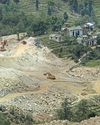An estimated 400 million people currently live in cities with perennial water shortage. The number is slated to go up to 1 billion by 2050 due to rising urban population and the impact of climate change.

THE CRISIS at Cape Town has shown what unplanned urbanisation can do to water availability in the world’s urban centres. Not only are our metropolises headed to a dry future, the scarcity will increase as people are migrating to urban areas at unprecedented rates. About 54 per cent of the world,or 3.9 billion people, live in urban areas and they will grow between 60 and 92 per cent by the end of the century, says a study published in Nature this January. As a result, the urban water demand will increase by 80 per cent by 2050, it adds. Most worryingly, “climate change will alter the timing and distribution of water,” it says.
About 400 million urban dwellers currently face water shortage, states a 2014 study published in Global Environmental Change (see ‘36 per cent cities to face water crisis by 2050’ on p54). This when the average global temperature has not even risen by 1.5°C above pre-industrialisation levels. What will happen when it rises by 2°C? A study, published in Earth System Dynamics in November 2017, has made projections for those scenarios. A 1.5°C rise in the average global temperature will expose 357 million urban dwellers to extreme droughts while the figure for a 2°C rise will be 696 million, it says (see ‘A dry future’ on p55). The number of city dwellers facing water shortage by 2050 could be much higher, about 1 billion, says the Nature study.
These rises in temperature are no longer hypothetical scenarios. A draft report by the Intergovernmental Panel on Climate Change (ipcc) leaked this February warns that the average global temperature is set to rise by 1.5°C by the 2040s. What will happen to our cities?
This story is from the March 15, 2018 edition of Down To Earth.
Start your 7-day Magzter GOLD free trial to access thousands of curated premium stories, and 9,000+ magazines and newspapers.
Already a subscriber ? Sign In
This story is from the March 15, 2018 edition of Down To Earth.
Start your 7-day Magzter GOLD free trial to access thousands of curated premium stories, and 9,000+ magazines and newspapers.
Already a subscriber? Sign In

A SPRIG TO CARE FOR
Punarnava, a perennial herb, is easy to grow and has huge health benefits

DIGGING A DISASTER
Soapstone mining near Dabti Vijaypur village has caused many residents to migrate.

REVIEW THE TREATMENT
Several faecal sludge treatment plants in Uttar Pradesh suffer from design flaws that make the treatment process both expensive and inefficient

MAKE STEEL SUSTAINABLE
As India works to double its GDP by 2030, its steel industry must balance growth with sustainability. By embracing policies like the Steel Scrap Recycling Policy 2019 and adopting green technologies, India is paving the way for a more sustainable future in steel production

Can ANRF pull off the impossible for India?
Anusandhan National Research Foundation is expected to reorient India's innovation goals but funding issues, old mindsets remain a drag

TROUBLED WOODS
Forests are a great bulwark against climate change. But this is fast changing. AKSHIT SANGOMLA travels through some of the pristine patches of the Western Ghats to explore how natural disturbances triggered by global warming now threaten the forest health

BLINDING GLOW
The science is clear: increased illumination has damaging consequences for the health of humans, animals and plants. It’s time governments introduced policies to protect the natural darkness and improved the quality of outdoor lighting.

GROUND REALITY
What happens when the soil loses the ability to grow healthy, high-yield crops on its own?

GM POLICY MUST BE FARMER CENTRIC
On July 23, the Supreme Court of India directed the Union government to develop a national policy on genetically modified (GM) crops for research, cultivation, trade and commerce through public consultation.

Vinchurni's Gandhi
A 96-year-old farmer transforms barren land into a thriving forest in drought-prone region of Satara